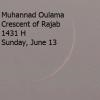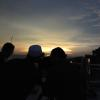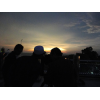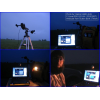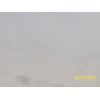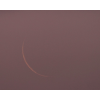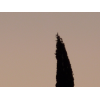Visibility of Rajab Crescent 1431 AH
- When to Observe Rajab Waxing (NEW) Crescent ?
- Rajab Waxing (NEW) Crescent Observation Results
- The OFFICIAL First Day in Different Countries
- When to Observe Jumadal Al-Aakherah Waning (OLD) Crescent ?
- Jumadal Al-Aakherah Waning (OLD) Crescent Observation Results
When to Observe Rajab Waxing (NEW) Crescent ?
The geocentric conjunction (Geocentric New Moon) will occur Inshalla on (Saturday 12 June 2010) at 11:15 UT.
Sighting the new crescent on (Saturday 12 June 2010) and (Sunday 13 June 2010) is shown in the below graphs using the program Accurate Times by Mohammad Odeh according to Odeh criterion. Where:-
- It is impossible to see the crescent from the areas located under the red color. Because either the Moon on this day sets before the Sunset and/or the topocentric conjunction occurs after the Sunset.
- The crescent is expected to be seen by optical aid only from the areas located under the blue color.
- The crescent is expected to be seen by optical aid from the areas located under the magenta color. In these areas the crescent could be seen by naked eye if the atmospheric conditions are superb and the observer is experienced.
- The crescent is expected to be easily visible by naked eye from the areas located under the green color.
- The crescent cannot be seen from uncolored areas, even though the Moon sets in these locations after the Sunset and the topocentric conjunction occurs before the Sunset, but the Moon is not sufficiently illuminated in order to be seen as crescent even by optical aid.
- Kindly notice that the below graph shows the possibility of seeing the crescent from areas between 60 degrees north of Equator down to 60 degrees south of Equator.
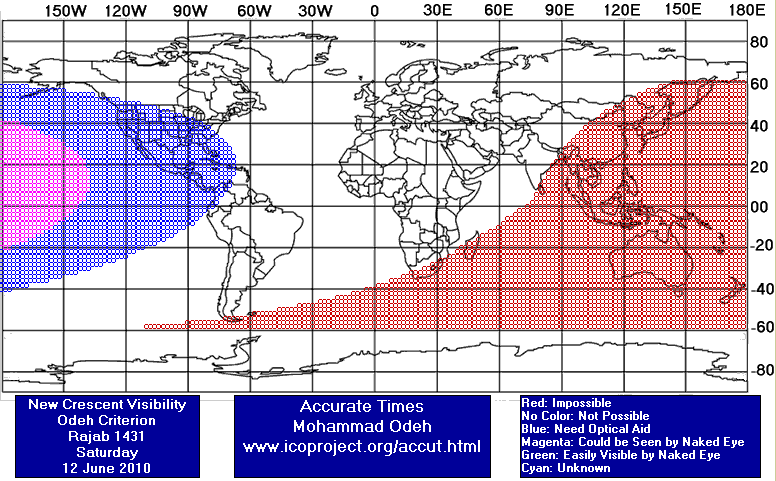
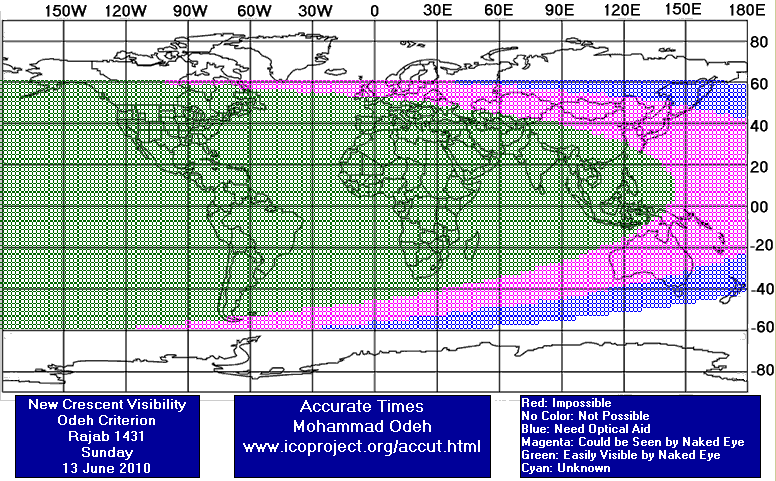
According to the Universal Hejric Calendar (UHC), which is based on the calculated crescent visibility, the start of this month in the Eastern Region will be > Monday 14 June 2010 and in the Western Region will be on > Sunday 13 June 2010. Kindly notice that the UHC is a pre-calculated calendar, which adopts a certain criterion to start the new Hejric month. Your country/organization might adopt different criterion to start the new Hejric month. So it is highly advised to read the UHC website before giving any judgment.
- Results of seeing the crescent, and the first day of the month in different countries will be added here Inshalla as we receive the reports from ICOP's members. If you wish to be a member in ICOP, or to know more about it, kindly click here.
Rajab Waxing (NEW) Crescent Observation Results
Sat 12 June 2010
Nigeria
Mr. Usman Dukku said: "It was cloudy, thus we did not attempt sighting the moon."
United States
Dr. Javad Torabinejad said: "This evening (Saturday, June 12, 2010), due to the presence of much haze and clouds no detailed sighting was attempted in Blacksburg, VA."
Mr. Jim Stamm said: "New Moon Crescent Observation Report ====================================== Observed: Saturday; June 12, 2010 - 7:45 (Local) Location (WGS 84) = Tucson, Arizona (USA) Longitude = 110.9651 W Latitude = 32.4206 N Elevation = 842 meters Time Zone = -7.0 hours Surface conditions at location: Temperature = 25 °C Humidity = 14 % Pressure = 29.78 in. Moderate haze and cloud bands in the west. Topocentric and local time values from “Accurate Times”: Sunset (at sea level) = 19:37 Moonset (at sea level) = 20:14 Time from new moon at 19:45 = 16 hr. 28 min. Moon lag time = 37 min. Relative Altitude = 6.7 degrees Elongation from sun = 7.7 degrees Crescent width = 9 arc seconds Illumination = .5 percent I was NOT able to see the crescent, even through a telescope. Sirius was a smudge. I only had a couple of minutes before the cloud bands interfered with my observation. I followed the position of the crescent through teh bands, but never saw it. Observer: Jim Stamm E-mail Address: StammJim@gmail.com"
Sun 13 June 2010
Bangladesh
Indonesia
Jordan
Ms. Basma Dhiab said: "It was a clear sky, and with 11 members of the Jordanian Astronomical Society and ICOP in addition to 5 children , we observed the new crescent easily. We were staning on the roof of a high building in Amman ( the capital of Jordan). "
Malaysia
Mr. Kassim Bahali said: "7 persons from Al-Khawarizmi Observatory tried to sight the hilal at Al-Khawarizmi Observatory at Tg. Bidara, 25 km from the capital of Malacca. The hilal was seen by naked eye and telescope Meade LX200 8” at 19:47pm after sunset (at 19:19). The western sky was partly cloudy. "
Nigeria
Mr. Usman Dukku said: "The crescent was easily visible after Maghrib prayer. Many of us saw it."
Mr. Abdul-Rasaq Abdul-Azeez Ishola said: "Aliamudulilahi I and Jamiu of Jamatu Ikorodu sighted The Rajab Crescent by Naked eyes in Jubilee Estate area of Ikorodu Lagos State Today of 13-06-2010 at 7:34 p.m.LT . Brother Bari Kerim called us of possitive report also."
Pakistan
Mr. Alam Sultan said: "Easily seen by others: On my request, Today (Sunday 13 June 2010 = 29 Juma-dath-thaniah 1431 in Pakistan) nearly three hundred persons (Members of the moon-sighting committees of our institute "JAMIA-TUR-RASHEED" + my friends + their companions) tried to sight the moon all over Pakistan and resultantly the crescent was easily seen by 17 persons at 3 places (Tando-Ghulam-Ali, Sindh & 2 places in Mardan, Khyber-Pakhtoon-Khah). Fortunately, it was generally clear there. Other members also tried to sight the moon at nearly 33 places countrywide but due to cloudy and rainy season the moon was not sighted. Note 1 : Chairman of central official moon sighting committee of Pakistan mufti Munee-bur-Rahman told me on my mobile phone that after receiving the positive reports, he officially announced that 1st Rajab 1431 will be on Monday 14 June 2010 in Pakistan after finishing the 29 days of Juma-dath-thaniah 1431. Note 2: After some days, inshaallah, a detailed report of this observation in Urdu will be available at www.esnips.com/web/moonnewsofjamiaturrasheed "
Saudi Arabia
Mr. Bander Albotehy said: "I came late to the sighting location which enforced me to stop and try finding the thin crescent by my naked eyes but I could not success especially with the partial clouds in the western horizon and loss of the sunset location. When I gave up, I called my team and they said that they saw it and it is still above the horizon. So, I joined the team (40 minutes after the sunset) and saw the very thin crescent by binoculars when it was about 5̊ above the horizon. Only 1 person (not me) out of 4 was able to see it by naked eyes (about 15 minutes after sunset) putting into your account that I joined them lately when the moon dropped to 5̊ above the horizon. In addition to the difficult horizon conditions, One possible reason could be added of not being able to see it by naked eyes is that the crescent was dropping into a location above lighted camp but the binoculars were power enough to gather the required crescent light.."
Senegal
South Africa
Tanzania
Mr. Zaffar Sheriff said: "With the duration (lag time) of one hour and a positive elongation of 14 degrees, there was no difficulty in spotting the 28hr crescent at 6.25pm, just 10 minutes after sunset. Earlier the crescent was seen with binoculars at 6.22pm."
Trinidad and Tobago
Mr. Kahiam Hosein said: "The crescent to commence the month of Rajab 1431 AH was CONFIRMED SIGHTED in Trinidad and Tobago, Barbados, Grenada and Guyana after the sunset of Sunday 13th June 2010. The sky was clear. Therefore the 1st night of Rajab is the night of 13th June 10 and the 1st day is the day of 14th June 10. (Mufti) Kahiam Hosein. On behalf of Darul Uloom Trinidad and Tobago Moon Sighting Committee."
United Arab Emirates
United Kingdom
Eng. Qamar Uddin said: "On Sunday 13 June 2010 (29 Jumada Al-Thani 1431 AH) many people from throughout UK have attempted to sight the youngest crescent moon (Hilal) of Rajab after sunset. Most places were cloudy and none of the groups were able to sight the 33 hours old Hilal by naked eye or telescopes. However, have received reliable sighting news from any countries from East of UK (including Morocco and South Africa). Therefore, the Ulama have decided that the month of Jumada Al-Thani 1431 AH will have 29 days and the month of Rajab 1431 AH will start from Monday 14 June 2010, Insha-Allah. May Allah rewards all those who have attempted to revive the Sunnah of moon sighting, this month. The Sutton Bank (North Yorkshire) group of 26 observers comprised of the following people. From Batley: Mufti Yusuf Sacha, Mufti Zakariya Akudi, Mualana Suleman Bodiyat, Mualana Hasuim Ravat, Mualana Qari Hanif, Mualana Suleman Makda, Mualana Musa Gora, Mualana Wasif Sacha, Mualana Habil Makda, Mualana Aslam Seedat, Mualana Kakani, Mualana Hashim Sacha, Maulana Hasib Mayet, Maulana Imran Lunat, Yusuf Mayet, Vaishullah Bodiyat, Mohammad Mayet, Kazi Sahib, Mohammad Naqi, Qari Islami Makda, Shokat Buai, Liyakat Buai, Nazir Bhana, Yusuf Kayat, Hanif Allad,; From York: Qamar Uddin. Note that the Sutton Bank (Thirsk, UK) group also live webcasted the observation efforts to the Internet (see attached photos)."
United States
Dr. Javad Torabinejad said: "This evening (Sunday, June 13, 2010), the crescent moon of Rajab was sighted in Blacksburg, VA, first by using binoculars (7X50) and immediately by naked eye. I arrived at the sighting location before sunset (sunset: 8:42 pm EDT) and left before moonset (moonset: 10:07 pm EDT). The first binocular sighting was at 8:47 (elevation of about 11 degrees). The horns were at 2:30 and 6:30 O'clock (2:30;6:00;6:30). The western horizon was partly cloudy."
The OFFICIAL First Day in Different Countries
Sun 13 June 2010
1 . Saudi Arabia
Mon 14 June 2010
1 . Bangladesh
2 . Indonesia
3 . Malaysia
4 . Nigeria
5 . Pakistan
6 . Senegal
7 . South Africa
8 . Tanzania
9 . Trinidad and Tobago
10 . United Kingdom
11 . United States
When to Observe Jumadal Al-Aakherah Waning (OLD) Crescent ?
The geocentric conjunction (Geocentric New Moon) will occur Inshalla on (Saturday 12 June 2010) at 11:15 UT.
Sighting the OLD crescent on (Saturday 12 June 2010) and on (Friday 11 June 2010) is shown in the below graphs using the program Accurate Times by Mohammad Odeh according to Odeh criterion. Where:-
- It is impossible to see the OLD crescent from the areas located under the red color. Because either the Moon on this day rises after the Sunrise and/or the topocentric conjunction occurs before the Sunrise.
- The crescent is expected to be seen by optical aid only from the areas located under the blue color.
- The crescent is expected to be seen by optical aid from the areas located under the magenta color.. In these areas the crescent could be seen by naked eye if the atmospheric conditions are superb and the observer is experienced.
- The crescent is expected to be easily visible by naked eye from the areas located under the green color.
- The crescent cannot be seen from uncolored areas, even though the Moon rises in these locations before the Sunrise and the topocentric conjunction occurs after the Sunrise, but the Moon is not sufficiently illuminated in order to be seen as crescent even by optical aid.
- Kindly notice that the below graph shows the possibility of seeing the crescent from areas between 60 degrees north of Equator down to 60 degrees south of Equator.


Jumadal Al-Aakherah Waning (OLD) Crescent Observation Results
Fri 11 June 2010
Germany
Eng. Martin Elsaesser said: "Despite the easy geometry of the crescent, it took almost half an hour to find it. This was due to haze and a large building being on fire in the next town, with the smoke obscuring half the horizon. Only when the crescent had risen several degrees could it be seen and remained difficult to see with naked eye. More info at http://www.mondatlas.de/other/martinel/sicheln2010/juni/sicheln201006.html"
United States
Mr. Jim Stamm said: "Old Moon Crescent Observation Report ====================================== Observed: Friday; June 11, 2010 - 05:08 (Local) Location (WGS 84) = Tucson, Arizona (USA) Longitude = 110.9651 W Latitude = 32.4206 N Elevation = 842 meters Time Zone = -7.0 hours Surface conditions at location: Temperature = 24 °C Humidity = 30 % Pressure = 29.57 in. No haze detected. Topocentric and local time values from “Accurate Times”: Moonrise (at sea level) = 04:14 Sunrise (at sea level) = 05:11 Time from new moon at 05:08 = 22 hr. 09 min. Moon lag time = 57 min. Relative Altitude = 10.4 degrees Elongation from sun = 12.1 degrees Crescent width = 21 arc seconds Illumination = 1.1 percent Crescent last observed through 9x63 binoculars: Time = 05:08 Moon Altitude = 8.0 degrees When the crescent was spotted at 04:57, I thought that it should be seen with the naked eye. However, I never did see it other than through the binoculars, although I think that someone with good eyesight could have seen it. Observer : Jim Stamm E-mail Address: StammJim@gmail.com "
